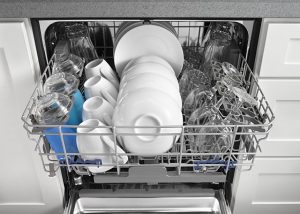1. A Lack of Rinse Aid
There are different rinse aid brands, but they all contain ingredients that are designed to rinse water from the surface of your cleaned dishes. When little or ideally no water is left on these surfaces, it can facilitate the drying process and reduce spotting. If you’re using an older dishwasher, you may find that you cannot even dry dishes without adding rinse aid. This is because of EPA rules introduced in 2010 when the use of phosphates was banned. Although the phosphates in dishwashing detergents were great for cleaning, it was a disaster for the environment due to the creating of algae blooms in water.
2. A Malfunctioning Heating Element
During a dishwashing cycle, the heating element becomes hot to raise the ambient temperature of the internal air. This is why it’s hot when you open the dishwasher door shortly after the cycle has finished. The heated air helps to evaporate the air from the surface of your dishes. Certain dishwashers may even have a fan that circulates the damp and hot air throughout the space to speed up the drying process further. If the heating element is damaged, this can lead to a lack of drying and wet dishes.
3. A Failing Condensation Drying Unit
Certain popular European appliance manufacturers developed a new condensation drying system that rinses dishes clean with a hot water blast. That heat is then used to condense the heat on the inner stainless steel surfaces of the dishwasher. This leaves the dishes clean and dry, but plastics don’t dry very well during this process due to poor heat conductivity. This has become a popular option in recent years and if the technology is failing, it can result in wet dishes and hand drying until it’s repaired.
4. Dishwasher Filter Cleaning
Many people are unaware that their dishwasher has a filter that needs to be clean and emptied periodically. Certain models may have a hard food disposal system, but this too can become clogged over time and this is not a common feature in modern units. The dishwasher filter is located under the water arm somewhere near the bottom of the cavity. This is a round unit that you can twist and lift out of the housing to empty the food debris, wash the unit and replace it. Larger filter units do exist, but they are still located under the water arm and you can find full details on how to clean them in your owner’s manual.
5. Top and Front Control Dishwashers
Although top and front control dishwashers look very different, they operate in pretty much the same way. The only real difference is the aesthetic appeal because top loading units have a smooth and sleek front panel. Both types of dishwashers are designed to dry the dishes using one of the processes mentioned earlier in this article. The addition of rinse aid will certainly help when you use any modern dishwasher no matter the format.
If your dishwasher is not drying your dishes there are a number of possible causes. If you’re experiencing these problems, you can rely on your local appliance technician to diagnose the underlying issue and affect a repair for you.
